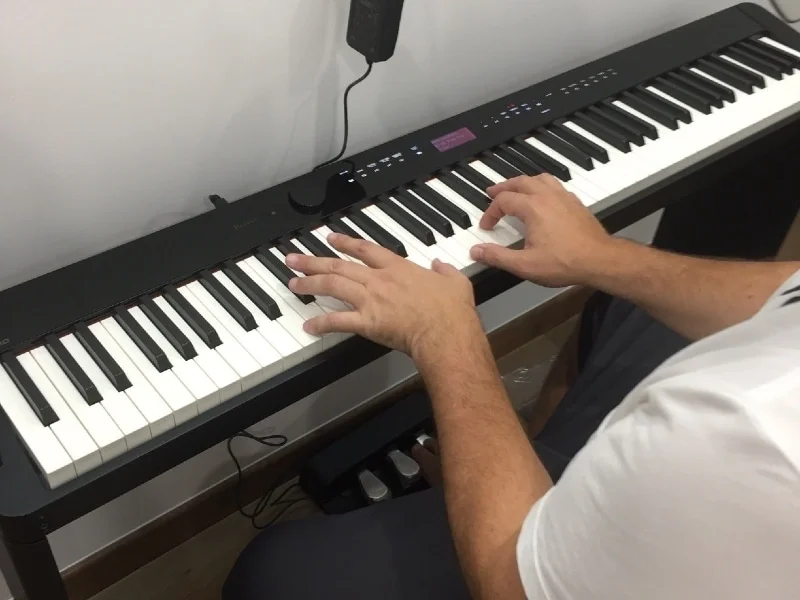Find out which piano is the better investment in this Yamaha DGX 670 vs Casio PX S3000 review!
There are many digital pianos below $1,000 that offer great value for the money. But today, we’ll only look at two of them – the Yamaha DGX 670 vs Casio PX S3000.
Both of the pianos come from respectable brands and are very affordable when you consider the features they offer. You can expect a realistic touch, great tones, and a wide array of features from either instrument, which is way more than you can ask for at this price point.
So, you can imagine how hard it was for me to choose a winner.
But after a lot of thought and rigorous tests, the Casio PX S3000 squeezed out the win. Since it came with more tones and a more realistic feel it beat out the Yamaha DGX-670. While the margins were thin, I’m confident that the Casio PX S3000 offers more than the Yamaha DGX-670.
And in this review, I’ll get into the details. That way, you know exactly why I think the Casio PX S3000 is the better pick.
Yamaha DGX 670 vs Casio PX S3000: Comparison Chart


Last update on 2025-04-18 / Affiliate links / Images from Amazon Product Advertising API
Yamaha DGX 670 vs Casio PX S3000: A Head-to-Head Comparison
I usually compare pianos based on three categories: feel, tone, and piano features. So, this is how I determined that the Casio PX S3000 is the better option. At the end of my full comparison, the score was 2-1 in favor of the Casio. So, it didn’t win by that much, but it’s definitely the better pick.
Keep reading to learn why.
Feel
The winner: Casio PX S3000
The first thing you notice when playing a digital piano is the feel, which is why it was my first comparison point between the two models. They both have decent hammer action systems, but I found that the Casio’s were a bit more realistic. And since the PX S3000 has simulated ebony and ivory keys, it feels way more realistic than the Yamaha DGX-670.
+Hammer Action
The Yamaha DGX-670 comes with the Yamaha Graded Hammer Standard or GHS. This is the first tier of Yamaha’s graded hammer action systems and does a great job of simulating a real acoustic piano. This is because the lower keys on the DGX-670 are significantly heavier than the lighter keys, which isn’t something you get that often in this price range.
That said, the GHS system is pretty basic compared to the Smart Scaled Hammer Action on the Casio model. While the two systems aim to accomplish the same goals, the Smart Scaled Hammer Action does it a bit better, which is why the Casio PX S3000 felt more realistic.
On top of that, the Casio PX S3000 comes with simulated ebony and ivory keys. The closest that the Yamaha gets to this is with the satin-like texture on the black keys. So, if you’re particular about a piano’s feel and want it to be as close to an acoustic piano as possible, the Casio PX S3000 takes the cake.
Tone
The winner: Casio PX S3000

The next comparison point I had was the tone. And while these two models were very close in terms of tone quality, the Casio PX S3000 has more tones. So, you have a more versatile sound library if you opt for the Casio.
+Tone Generator
I had no complaints when it came to the tone qualities on these pianos. This is because they both use top-tier and premium tone generators that produce a rich and detailed voice. The Yamaha DGX-670 features the CFX Sound Engine while the Casio uses Multi-dimensional Morphing AiR.
While they have different names, they work in a similar way. Both pianos are loaded with very high-quality samples recorded from real instruments. And whenever you press a key, you trigger the samples.
There was barely a difference in tone quality between the two. Both sounded very realistic. However, I did note that Yamaha’s tones were a bit brighter than Casio’s, which might be what you prefer.
+Sound Library
The main reason the Casio PX S3000 won this point was its sound library. It features a 700-voice sound library that has more than you will need a pianist. Whether you’re looking to play traditional piano sounds, synth sounds, or even create a drum break, this instrument has exactly what you need and then some!
On the flip side, the Yamaha DGX-670 boasts a great sound library too. The piano features more than 600 different sounds and all of them are great. Even so, the Casio PX-S3000 still has more options which is why it won this comparison.
Piano Features
The winner: Yamaha DGX-670

The one area where the Yamaha DGX-670 outperformed the Casio PX S3000 was in the piano features. The Yamaha model has higher polyphony and a great set of effects. And even if the two were on par in terms of playing modes, it would have been nice to see better polyphony on the Casio PX S3000.
+Polyphony
There was no debate about which piano has better polyphony. The Yamaha DGX-670 comes with 256-note maximum polyphony, which is the highest rating in this price range. On the flip side, the Casio PX S3000 only has 192-note polyphony. It isn’t that far behind, but the DGX–670 is the clear winner.
The reason this is important is that better polyphony gives you more flexibility. When you use the Yamaha, you can play more notes at the same time. While you won’t need this when playing regular piano pieces, it’s essential if you use the sustain pedal, have MIDI backing tracks, or use the layering mode to blend two voices.
+Effects
Both pianos come with chorus, reverb, EQ, and DSP effects. However, the reason the Yamaha won out was because of the presets. The Yamaha comes with many presets for both reverb and chorus effects that you can tweak according to your liking. This makes it easier to emulate and achieve the tone you want.
The Casio PX S3000 doesn’t come with the same presets so getting the exact sound you want is much harder. So, when comparing the piano features, the Yamaha DGX-670 won convincingly.

Yamaha DGX 670 vs Casio PX S3000: The Similarities
There are quite a few similarities between these two pianos. To start, both of them are arranger pianos. This means that aside from the wide sound libraries, both pianos can also play backing tracks so that you have a fuller sound. This is very useful when performing live or creating demos to record in the studio.
On top of that, both pianos are portable. This is great for performing musicians as you won’t have a hard time bringing your gear to the gig. If you’re looking for versatile pianos that can handle all your needs on stage, these are some of the best options in this price range.
And even if I found the Casio PX S3000 to be the better option, there’s no doubt the Yamaha DGX-670 would be a good choice as well.
Quick Rundown of the Yamaha DGX 670
- CFX Stereo Sampling faithfully reproduces the sound of Yamaha's flagship CFX Full Concert Grand.
- GHS weighted action is heavier in the low keys and lighter in the high keys, just like an acoustic piano. The special matte black key tops are designed to absorb moisture and remain tactile after extended use without becoming slippery.
- Adaptive Style automatically shifts between the Main Style Variations by changing your velocity and number of notes played.
- Unison and Accent function adds a doubled voice to your melody line and musical "hits" when you accent your notes.
- Smart Chord lets you play great-sounding chords from simple Pop triads to complex jazz 7th chords with just a few fingers.
Last update on 2025-04-18 / Affiliate links / Images from Amazon Product Advertising API
Quick Rundown of the Casio PX S3000
- 88-key Stage Piano with 192-note Polyphony
- Smart Scaled Hammer-action Keyboard
- Onboard Effects - Black
- 200 Rhythms
- 700 Sounds
Last update on 2025-04-18 / Affiliate links / Images from Amazon Product Advertising API
Product Video
Related Articles to Yamaha Dgx 670
- Yamaha DGX-670 vs YDP 144: Finding the Best Digital Piano
- Yamaha DGX 670 vs Roland FP 60x: Which Piano Comes Out on Top?
- Yamaha P125 vs DGX 670: Which Piano Comes Out on Top?
- Yamaha DGX 670 Vs P515: Which Gives You Bang For Your Buck?
- Yamaha DGX 670 Vs 660: The Distinct Difference In Details You Need To Know About
- Yamaha DGX 670 Vs Roland FP 30x: Which Works Better For Your Needs?
References:
- Yamaha DGX 670: https://www.sweetwater.com/store/detail/DGX670BK–yamaha-dgx670b-88-key-black-portable-grand-includes-pa150-power-adapter-and-sustain-pedal-black
- Casio PX S3000: https://www.casio.com/ph/electronic-musical-instruments/product.PX-S3000BK/
Lulacruza is an electronic folk duo operating at the junction of the hypermodern and the ancient. Our music weaves together hypnotic female singing, South American folk instruments and electronic processing, while channeling pulsating waves from the source of creation.
Lalucruza is also a community where you can connect with other music lovers to collaborate, exchange ideas and share knowledge. A platform for who wants to learns the basics of playing piano, guitar, drum masters’ technique, etc.. is the premise of our website.
